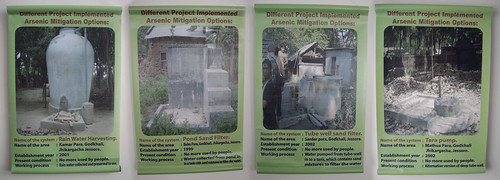 Please check out our 1-min video “Water Collaborations” by following this link. Some of you might already have seen it: a team of contractors installing a deep tube-well and children taking water from it. To vote for us, you can click on the ‘heart’ just under the video. Thank you!
Please check out our 1-min video “Water Collaborations” by following this link. Some of you might already have seen it: a team of contractors installing a deep tube-well and children taking water from it. To vote for us, you can click on the ‘heart’ just under the video. Thank you!
Digest 10/2013: Arsenic in the news
 Please have a read through this news digest of recent online publications on arsenic.
Please have a read through this news digest of recent online publications on arsenic.
There is no safe limit; trace amounts of arsenic can also do damage
It was formerly thought that only high dose exposure resulted in illness, but new research begs to differ. Trace amounts of arsenic in the body interfere with the tumor suppressing hormone glucocorticoid, while damaging lung cells and causing inflammation in the heart. Researchers at the University of Chicago found residents of Bangladesh who took in as little as 19 parts per billion (ppb) had reduced lung function and at 120 ppb, their ability to take in oxygen was reduced.
Continue reading
Observing Global Handwashing Day
 Global Handwashing Day is a campaign to motivate millions around the world to wash their hands with soap. This is the single most effective and inexpensive way to prevent diarrhea and acute respiratory infections, such as pneumonia. The campaign is dedicated to raising awareness of hand washing with soap as a key approach to disease prevention. Every year, organisations all over Bangladesh celebrate this day from the national to the community level. Continue reading
Global Handwashing Day is a campaign to motivate millions around the world to wash their hands with soap. This is the single most effective and inexpensive way to prevent diarrhea and acute respiratory infections, such as pneumonia. The campaign is dedicated to raising awareness of hand washing with soap as a key approach to disease prevention. Every year, organisations all over Bangladesh celebrate this day from the national to the community level. Continue reading
“Water Collaborations” screened at the Budapest Water Summit
 Our video “Water Collaborations” was screened alongside other short films related to water at the Budapest Water Summit. These were selected from the Green-Go Short Film Contest.
Our video “Water Collaborations” was screened alongside other short films related to water at the Budapest Water Summit. These were selected from the Green-Go Short Film Contest.
Formation of a new Community-Based Organisation
 AMRF recently facilitated the formation of a new Community-Based Organisation (CBO) for safe water and sanitation activities in Ward-3 of Birtara Union (A Union is the smallest administrative area in Bangladesh. It is divided in 9 Wards, each usually covering one village). We divided the Ward in smaller clusters where villagers elected two or three representatives, forming small peer groups. In every cluster we carried out Community Situation Analyses, which includes the development of social and physical maps and household surveys. All the peer groups in the Ward were then invited to attend a Ward-level meeting to discuss the election and establishment of a CBO. One of our preconditions is that the CBO members are local, poor and involved on an honorary basis. Continue reading
AMRF recently facilitated the formation of a new Community-Based Organisation (CBO) for safe water and sanitation activities in Ward-3 of Birtara Union (A Union is the smallest administrative area in Bangladesh. It is divided in 9 Wards, each usually covering one village). We divided the Ward in smaller clusters where villagers elected two or three representatives, forming small peer groups. In every cluster we carried out Community Situation Analyses, which includes the development of social and physical maps and household surveys. All the peer groups in the Ward were then invited to attend a Ward-level meeting to discuss the election and establishment of a CBO. One of our preconditions is that the CBO members are local, poor and involved on an honorary basis. Continue reading
Introductions
Featured
The problem at a glance
Contamination of groundwaters with arsenic poses a major health risk around the world, but it is in Bangladesh that the worst mass poisoning in history is taking place. Millions of rural poor are drinking water containing high levels of arsenic. Although the problem has long been recognised, little has been achieved to resolve it. Among the few projects that are being implemented, even fewer have managed to reach the poor and to bring about lasting results. The urgent and complex character of the arsenic crisis requires an integrated and participatory program that links research and implementation in a manner that reflects the priorities of local communities.
An 8-minute video introduction
 Please see here for the full 1-hour video documentary.
Please see here for the full 1-hour video documentary.
Who we are
The Arsenic Mitigation and Research Foundation (AMRF) is a joint effort between academic researchers, medical doctors and development practitioners. Our program aims to establish safe water and health support in arsenic-affected and marginalised communities, and to derive lessons from these experiences for replication elsewhere in Bangladesh and in other countries facing similar challenges. Please download our flyer for more information. You can also find us on Facebook and Twitter.
 Latest news
Latest news
Community Situation Analysis in new working areas
 Weeks before the installation of a deep tube-well, our field staffs start surveying the village and test its tube-wells. They also initiate conversations with villagers about what other arrangements, apart from the deep tube-well itself, would be required for a well-functioning community-based drinking water supply: a bank account would have to be opened for saving water user contributions to maintenance; spare parts and materials would have to be purchased; a committee would have to be set up to act on the decisions and to take on maintenance responsibilities; accessible land space would have to be found for the water supply. Continue reading
Weeks before the installation of a deep tube-well, our field staffs start surveying the village and test its tube-wells. They also initiate conversations with villagers about what other arrangements, apart from the deep tube-well itself, would be required for a well-functioning community-based drinking water supply: a bank account would have to be opened for saving water user contributions to maintenance; spare parts and materials would have to be purchased; a committee would have to be set up to act on the decisions and to take on maintenance responsibilities; accessible land space would have to be found for the water supply. Continue reading
When the solution is the problem
For long, the idea of technology transfer dominated the development discourse. It was assumed that modern industrial technology could be transferred from the North to benefit the South. At the same time, local or traditional technology was generally undervalued. The transfer of technology often led to a mechanism where it sustained and promoted the interests of dominant social groups who had the capacity to access, use and maintain those technologies (Dickson 1974). In a previous post, we have discussed how many of the Safe Water Options (SWOs) installed in response to the arsenic crisis have been distributed to influential or well-connected families. So-called community-based SWOs are in reality privately used by the rural elite. Beyond the direct issue of access to safe water, the impacts could be far reaching. Continue reading
Health insurance for the rural poor
 For the poor in Bangladesh “health insurance” is an unknown concept. It is generally assumed that they would not be able to afford such type of social protection. It has been suggested that non-profit, mutual, community-based health insurance schemes may improve their access to health care of acceptable quality. In many countries around the world such schemes have emerged. They are characterised by an ethic of mutual aid, solidarity and the collective pooling of health risks. In several countries these schemes operate in conjunction with health care providers, mainly hospitals in the area. More information on the concept and resources can be found here. We are considering facilitating the development of such a scheme through the activities of our Community Clinic.
For the poor in Bangladesh “health insurance” is an unknown concept. It is generally assumed that they would not be able to afford such type of social protection. It has been suggested that non-profit, mutual, community-based health insurance schemes may improve their access to health care of acceptable quality. In many countries around the world such schemes have emerged. They are characterised by an ethic of mutual aid, solidarity and the collective pooling of health risks. In several countries these schemes operate in conjunction with health care providers, mainly hospitals in the area. More information on the concept and resources can be found here. We are considering facilitating the development of such a scheme through the activities of our Community Clinic.
Nothing new under the sun: the global failure of water projects
We recently reported on a study revealing that up to two thirds of the drinking water supplies established in response to the arsenic crisis became inoperative (in highly contaminated areas). Improve International collects statistics showing that failure rates for water systems are high in many parts of the world. It is particularly tragic that this is old news. Referring to research and field observations from the 1970s, USAID wrote: “the main obstacle in the use and maintenance of improved water and sanitation systems is not the quality of technology, but the failure “in qualified human resources and in management and organisation techniques, including a failure to capture community interest” (Nieves, 1980). An appalling 35 to 50 percent of systems in developing countries become inoperable after five years.” (USAID (1981) quoted by Improve International) In our view, failures are not so much related to the communities’ lack of skills or interest. They are related to our own failures as intervening agencies. Without appropriate ways of collaborating with marginalised social groups (communities are not homogenous), the solutions won’t fit culturally and economically. As a result, they will generally not last.

